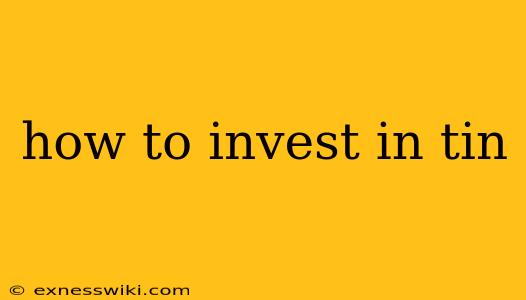Tin Investing: A Shiny Opportunity in a Modern World
Remember that old tin lunchbox you used to have as a kid? That iconic, durable metal that held your sandwiches and snacks? Well, tin, or tin, as it’s formally known, is still relevant today, playing a crucial role in modern industries and technologies.
It's been a while since I've seen a tin lunchbox, but I still remember its heft and durability. It felt like it could withstand anything. That's what I associate with tin: strength and resilience. And it turns out, these qualities are highly sought-after in the world of electronics and manufacturing.
Tin: A Strategic Metal with Growing Demand
Tin is a strategic metal, meaning it’s crucial for national security and economic well-being. It's a key component in solder, the material that connects electronic components, making it indispensable for smartphones, computers, and other high-tech devices. It also finds applications in food packaging, automotive parts, and solar panels.
The demand for tin is expected to grow significantly in the coming years. This growth is driven by the increasing production of electronic gadgets, the expansion of the electric vehicle market, and the global push towards renewable energy solutions. Global tin consumption is estimated to reach around 400,000 metric tons by 2025, according to the International Tin Association.
Investing in Tin: Options for the Savvy Investor
So, how can you capitalize on this growing demand for tin? Here are some ways to invest in this shiny metal:
1. Tin ETFs and Mutual Funds:
- ETFs (exchange-traded funds) and mutual funds provide a diversified way to invest in tin.
- These funds track the price of tin on global exchanges, giving you exposure to the commodity without needing to buy physical tin.
- Popular options include the iShares Global Infrastructure ETF (IGF) and the Invesco DB Commodity Index Tracking Fund (DBC), which include tin among their holdings.
2. Tin Mining Stocks:
- If you prefer a more direct approach, consider investing in tin mining companies.
- These companies explore, extract, and process tin ore, offering potential upside as tin prices rise.
- However, investing in mining stocks carries inherent risks, including volatility and operational challenges.
- Research the companies thoroughly before investing, looking at factors such as production capacity, operational costs, and regulatory environment.
3. Physical Tin:
- For those seeking physical ownership of tin, consider buying tin bars or coins.
- These can be purchased from reputable dealers and stored securely.
- However, physical tin requires storage and security considerations.
4. Tin Futures Contracts:
- Futures contracts allow you to buy or sell tin at a predetermined price and date in the future.
- This can be a good option for speculators who believe tin prices will rise or fall significantly.
- However, futures trading is complex and carries significant risk, particularly for novice investors.
Before you invest in tin, it’s essential to:
- Understand your risk tolerance: Tin prices can fluctuate significantly, so consider your comfort level with risk.
- Do your research: Thoroughly research investment options, including companies, funds, and market trends.
- Diversify your portfolio: Don't put all your eggs in one basket. Include tin investments as part of a diversified portfolio.
Conclusion
Tin is a valuable and strategic metal with a bright future. As technology and industry continue to rely on its properties, demand is expected to increase, presenting an opportunity for savvy investors.
Remember my old tin lunchbox? That sturdy metal that held my childhood memories? Today, tin is more than just a durable material; it's a symbol of the future, a key component in the technologies shaping our world. Invest wisely and you might just find yourself holding a piece of that future.
